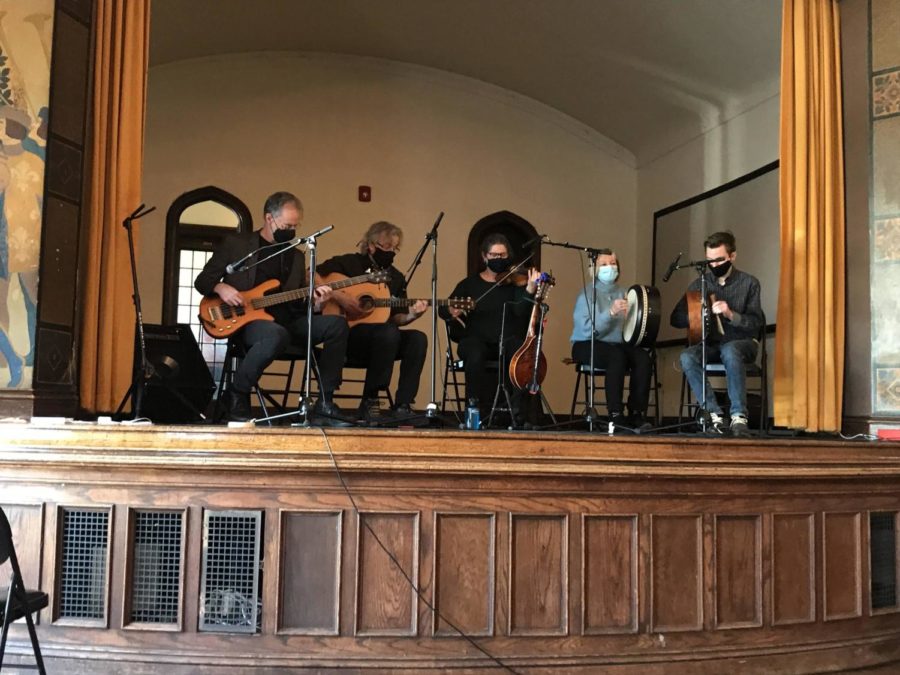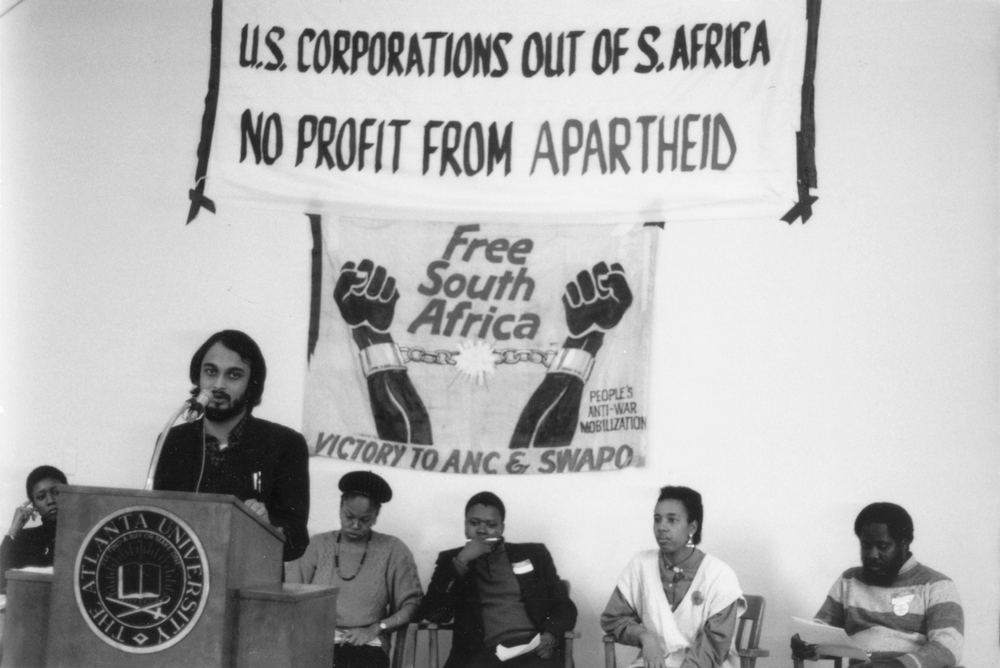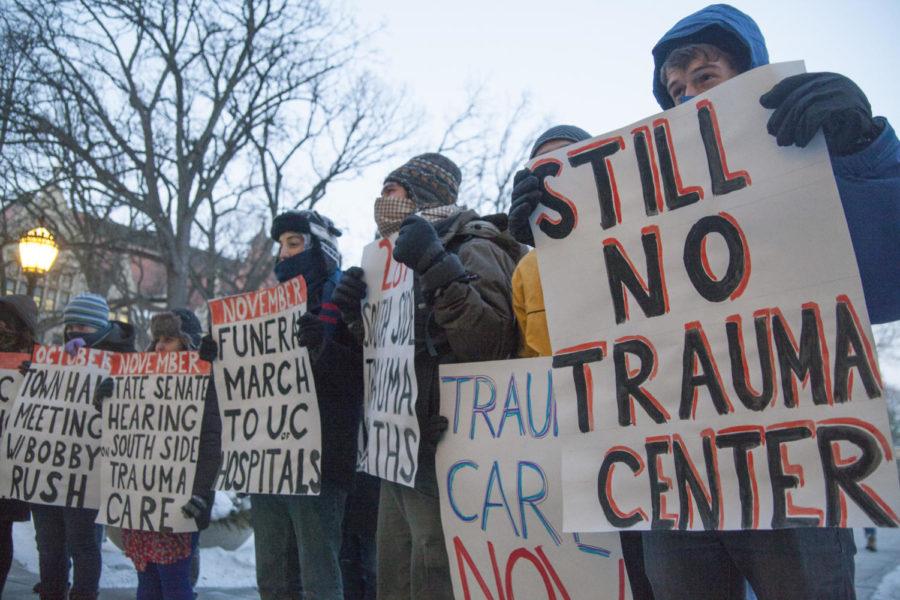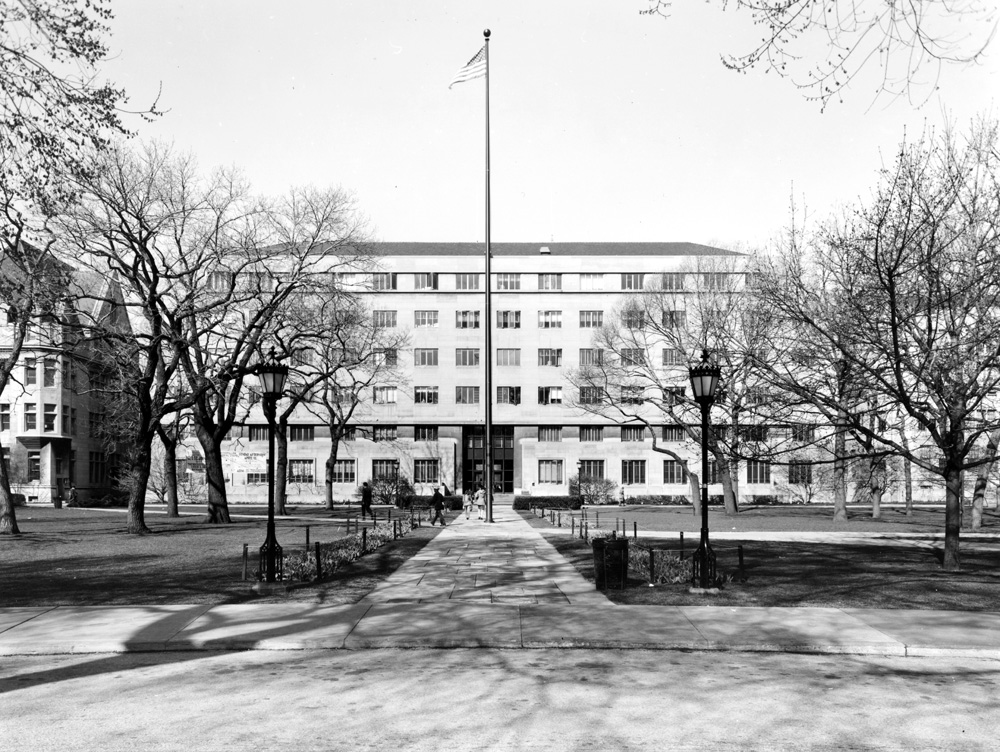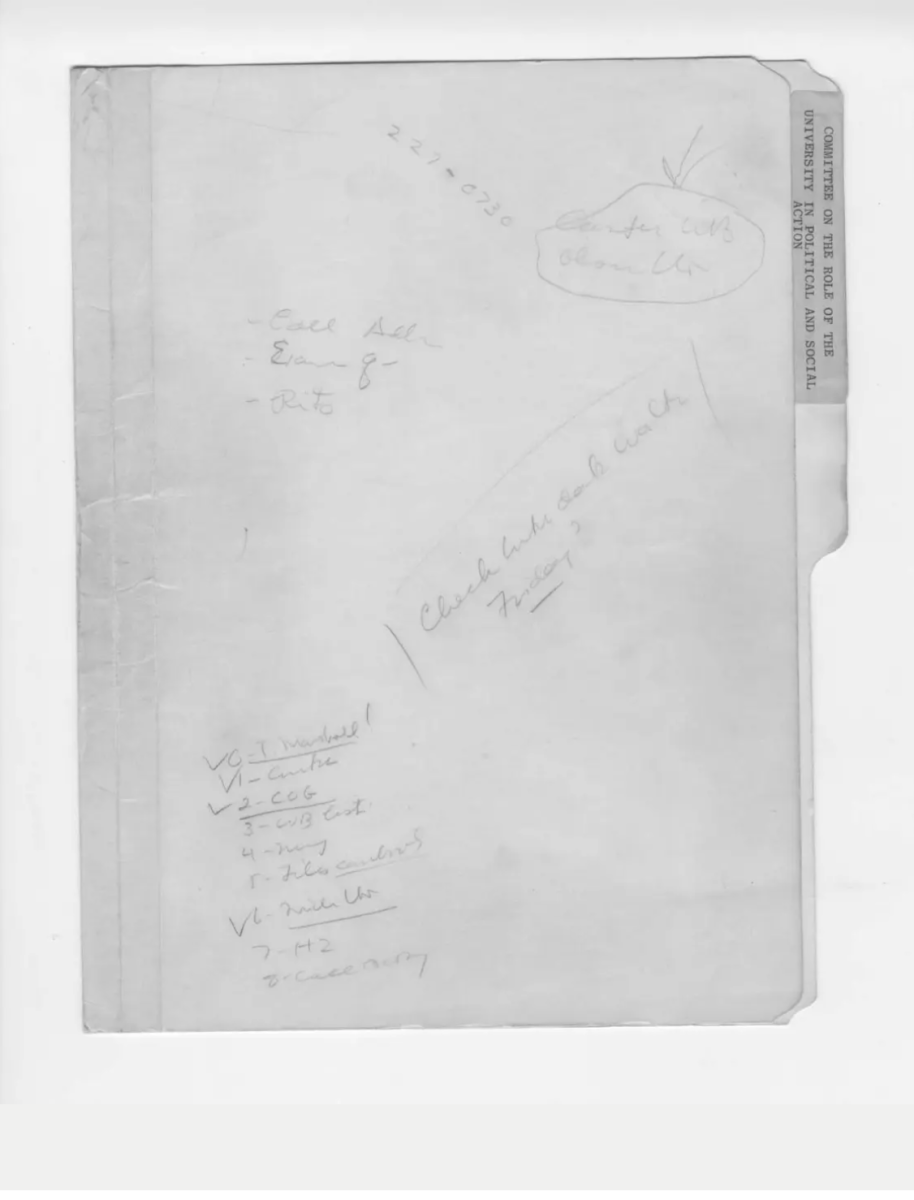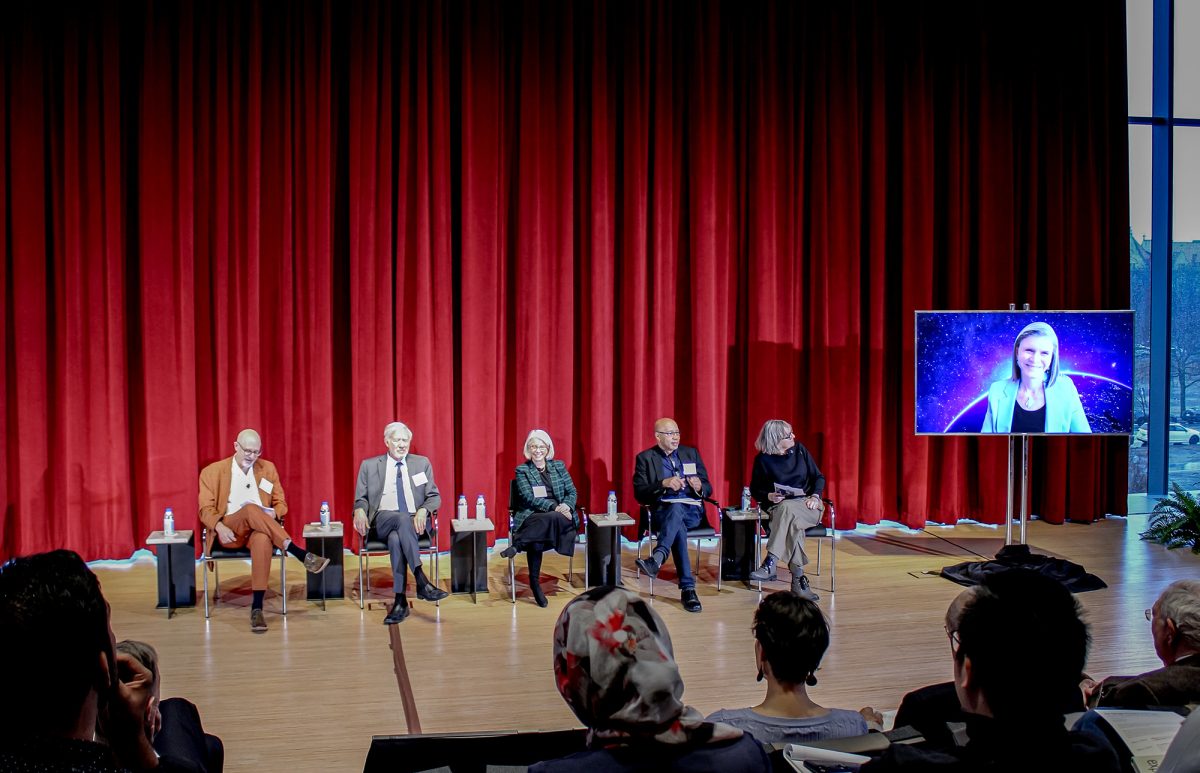On an unremarkable February day, a silver-haired Irish musician from South Bend called joHn Kennedy (who stylizes his name to differentiate himself from the president) confidently tells me that the fundamental tradition of folk music is that it’s “just part of everyday life.”
A hearty yet understated consistency, like an unbuttoned flannel shirt, is one proud attribute of folk music, the genre celebrated at the 62nd Annual University of Chicago Folk Festival. The other is the genre’s broad musical range. A patchwork of performances gracing the festival ranged from “coal-fired” Kentucky bluegrass to traditional Kyrgyz komuz and electrified Chicago blues.
On the surface, there is no clear or stable musical connection between these disparate acts. And yet, despite a dearth of unity or mainstream appeal, the genre survives. The UChicago Folk Fest, organized and run by the Folklore Society—a flannel-wearing, multigenerational group—reaffirmed that folk music is a genre which transcends the rigid limits of music itself.
Rather, the life-force of the folk genre lies outside and in-between the songs. It survives in its self-mythology and tall tales. It’s a genre of recollection and name-dropping and murmurs—a flawed but fitting reflection of the cultures, traditions, lives, and lores of its performers and interpreters. It tells itself stories in order to live.
I. Music, Muses, and Running Water
joHn Kennedy is an economics professor by trade, a bard at heart, and the bandleader and eponymous kitchen owner of Kennedy’s Kitchen, an Irish band from South Bend, Indiana. The troupe of kind-hearted performers is among the handful of acts who converge on campus early to livestream workshop sessions from Ida Noyes Hall hours before the main evening concert in Mandel Hall. Although there are only a handful of volunteers watching the show, dispersedly dotting the covid-conscious concert hall, the band is more than content. “It’s like heaven,” Kennedy marvels with sincerity at the acoustics in Ida Noyes, noting that at the very least it’s better than rehearsing in a basement.
On the Kennedy’s Kitchen website, Kennedy lists his skills as “vocals, guitar, tin whistle, bouzouki, bodhran, banjo, and embellished stories.” Before strumming his guitar or parting his woodwind-friendly mask to blow on his penny whistle, Kennedy exhibits his tall-tale-telling title. Speaking to a phone propped on a music stand in lieu of a functioning camera, Kennedy jokes to the livestream, “If you go to an Irish show—and I hope you do!—and the introductions are not longer than the songs, you can demand your money back.”
This must be a real Irish show. Time passes leisurely as Kennedy recounts his musical heritage, dredging up family lore from his grandmother’s two-room cottage in County Donegal with 13 people jammed inside. “There’s no electricity, running water is”—he cups his hands over his mask and projects a lilted shout across the sparsely populated theater—“Brigid, run down to the lake and get some water!”
The “embellished stories” that Kennedy divulges before each song legitimizes the songs’ reinterpretations to a new audience every night. They ground the songs in tradition, giving them context and heart, beckoning the listener closer to their original context.
As a final reminder before the songs commence, Kennedy adds that the renditions are far from what was originally intended. These songs were never written for a band with an electric bass to belt out in concert halls for Facebook live-streams. They were originally performed with the voice alone—sung not for performance but for practical and personal reasons. To accompany the laundry folder, to synchronize the dishwasher, to comfort the lonely. Sparse and lovely songs to make you feel better and to help you live.
When it finally comes, the haunting Irish melodies, dripping out of the instruments, are rich, echoing off the muraled walls in the Ida Noyes theater, seemingly just a few notes away from compelling the oil-paint muses and nymphs into fluid motion. Among the Kennedy’s Kitchen-branded kazoos and shot glasses hawked at the entrance, far away from the crammed cottage and laundry line, these songs still help us feel better and help us live.
II. Controlled Chaos and Other Oxymorons
It’s 4:50 p.m. on Saturday and David Waldman, a staple in the Folklore Society, an esteemed harmonica player, and a respected presence in the remains of the Chicago blues scene, asks me the time. Ten minutes until the blues band’s soundcheck, and Taildragger, the front man, has yet to arrive.
Amid the bustle of Mandel Hall, Taildragger’s tardiness barely makes a ripple. On the stage, industrious student volunteers hustle with the air of authority that comes from wearing a headset or carrying a clipboard. Some seek out tasks with their hands on their hips, others let their arms hang limp. Cables, cameras, microphones, monitors, lights—plugged, unplugged, arranged, calibrated, rearranged.
Beneath the surface, down drafty backstage stairs and through unmarked doors, artists mingle in the basement green room. Room is a generous term—one side of the narrow hall is lined with wooden armchairs and a sofa; the other is populated with tea and coffee samovars on folding tables and Diet Pepsi in an old white fridge. On the far side from the stairs, artists sit in cinder block dressing rooms and wait their turn to lumber back up the breezy stairs and to burst into the spotlight. But for the moment, Taildragger is AWOL.
Months prior, when the time came for the club to find a blues act for the festival, Waldman presented the Folklore Society with a slate of options. The Folklore folks were soon sold on Taildragger, however, after watching a grainy and surreal VHS recording of Waldman and Taildragger performing together in an old Chicago fish market.
Waldman was careful to provide the Folklore Society with a handful of warnings about its chosen act. For one, Taildragger was a gravelly-voiced, finger-pointing vocalist accustomed to smoky and claustrophobic juke joints—not carpeted, cavernous university auditoriums.
But Taildragger’s music was hardly the draw for the Folklore Society. Swirling legends and controversies have surrounded Taildragger for decades, inflating his presence and mythology in the minds of the students.
To his credit, Waldman tactfully disclosed Taildragger’s darkest lore. In 1993, Taildragger was convicted of second-degree murder after shooting and killing fellow blues musician Boston Blackies in alleged self-defense. The collective memory of the event, formed by Waldman’s recollections, news reports, and other hemming and hawing rememberers, is decidedly hazy. There may have been disputes over money. There may have been deeper personal tension. Boston Blackie may have rushed at Taildragger with a knife. The truth is somewhere amid the uncertainty, obscured by decades of rumors and exaggeration. What is certain is that Taildragger served 17 months and three days of a four-year sentence in prison and is now under contract to perform at Mandel Hall.
Somewhere else, some other time ago, back down that same unreliable road which passes by definite memory, James Yancy Jones was renamed “Taildragger.” By most accounts, the legendary Howlin’ Wolf bestowed his young protégé with the moniker for his track-record of tardiness. Back in the present, as his crack backing band—hand-picked by Waldman and nicknamed “the All-Stars” for the gig—mills around the green room, the octogenarian Taildragger continues to live up to his name.
Pulled away from the controlled chaos within Mandel Hall, I find myself with Waldman on the cold corner of 57th Street and University Avenue, frantically looking up and down the streets, peering into each passing car, calling his phone repeatedly and leaving tense messages. “Taildragger,” Waldman inquires, “how and where are you?”
After making unsteady visual contact with Taildragger, Waldman and I rush to the middle of the road, flailing our arms frantically, flagging down a swerving sedan. Eventually, Taildragger and his three-woman entourage pull over in front of the Reynolds Club. Taildragger folds himself out of the car, pops the trunk, and tells me to grab his CDs. I don’t give it a second thought.
His presence is imposing, almost biblical, and the seas of mulling volunteers part as he passes through the lobby. He wears a long black leather trench coat with fur lapels, black snakeskin boots, a black Colonel Sanders string bow tie, and a wide-brimmed black cowboy hat pulled down low over his brow. He walks slowly, leaning on a black cane, and he is silent as he walks.
“Have no fear,” Waldman announces to the other artists and scattered volunteers as we reach the green room, “the Taildragger is here!” Taildragger nods and sits down.
As a volunteer-slash-reporter myself, I spend some more time keeping busy and keeping up the appearance of being busy before bumping into Martin Lang, Taildragger’s harmonica player. He’s coming inside from a smoke in his leather jacket and cap, clutching a worn leather satchel stuffed with harmonicas, mics, and cables.
“Excuse me, are you Martin Lang?”
“Whatever’s left of him.”
Tucked in the corner of the backstage stairs, Lang’s remains relate to me tales of days of yore, when he was a philosophy undergraduate at UChicago. “If anyone tells you that you can’t have fun at the U of C…”
He trails off verbally, recalling the inflection point of his professional life. While walking to the Reg one morning, philosophy tomes tucked under arm, Lang was stopped in his tracks by a beckoning voice from behind—the voice of Waldman, a graduate student at the time. The two blues harpists talked shop, and Waldman demonstrated a superior tongue positioning technique. By the end of the conversation, Waldman had agreed to take Lang under his wing. Lang’s stubbled mouth smirks as he recollects spinning on his heels away from the Reg to hunt his harmonica future. Lang supposedly found his fun and his career at UChicago. The rest is history, or so the story goes.
III. Memories, like “Pink Lipstick on a Lit Cigarette”
Your average Folk Fest attendee is oblivious to this bulging yet managed chaos in the bowels of Mandel Hall. Come show time, the spectator enters a shadowy and ornate cathedral to song and performance. All is calm and the lights are dim. Then the doors crack like a snare and the bagpipes with a Highland shriek cut through the din.
Saturday night at the Folk Fest officially begins with a no-frills Illinois Old Time group—an unassuming troika of Chirps Smith on fiddle, Fred Campeau on banjo, and Steve Rosen on guitar. A spry Dorothy Kent step-dances by their side every few songs, adding a percussive flair to the strings.
Step dancer or not, the songs are thoroughly incomplete without Smith’s deadpan introductions of their carnivalesque beginnings. Smith relates the origin story of one “fun little tune” by the name of “Wolf Creek,” which he learned from Harvey—“everybody called him Pappy”—Taylor, who himself learned from Joe Dixon, a fiddler for a traveling circus in the year of who knows when.
In Smith’s musical lineage, to play a song without its introduction and history is to play a soulless collection of notes and rhymes out of context, removed from the tradition that gives each tune its enduring worth and relevance.
As the understated Old Time music fades into memories, Taildragger, clutching his cane, makes his way to centerstage before sighing into an out-of-place wooden chair. “Now don’t make fun of me,” he quips to the audience. “If you keep on living, one day you’re gonna take a seat too.”
Yet the elder bluesman at times heaves himself out of the chair and tilts towards the audience. Hat pulled low and microphone coiled in the one hand, Taildragger waggles his finger at the crowd and shakes his hips in coordination with the electrified blues howls of the All-Stars. His voice is a rough growl and rattles with the blood of many things, among them, the blues. As spectators turn to dancers in the aisles, swaying with the stomping rhythm section, I catch his approving nod.
By the time the set is slated to end, Taildragger is just settling into his groove. But a series of frantic behind-the-curtain gestures, relayed between volunteers, culminating in Lang slashing a pointer finger across his throat, finally convinces Taildragger to take a bow.
As the all-white All-Stars break down their equipment, Taildragger, traveling light, moseys back down the stairs. Various anonymous stagehands and hangers-on compliment his performance, and his mouth turns up at the corners as he mumbles vague thanks.
I tail Taildragger down to the emptied out green room. We space out and sit silently on sofas as overhead speakers transmit a tinny rendition of Kennedy’s Kitchen’s act. And we’re couched in silence and surreality as the All-Stars and their kith and kin trickle down to grab Diet Pepsi from the fridge and reach the mellow verdict that the set was not all that bad despite a few hiccups.
The stoic bluesman remains draped on a small wooden chair like some feudal lord, surveying those of us milling about, until he is prodded into conversation by his band and Waldman. The performativity of the conversation in the basement equals the raunchy renditions of blues standards on the stage minutes before. A member of the posse need only drop a name to launch a story. What about that freckle-faced woman who had a child with Hubert Sumlin? Is Bowtie still alive? Wasn’t Eddie Taylor really something? Then there’s Rockin’ Johnny Burgin and Jimmy Burns and Jimmy Reed.
These are names connected by a vague semblance of community formed in run-down, burned-out blues joints on the south and west sides. Anecdotes linked by a collection of riffs and chord progressions ingrained into every guitarist’s fingertips. Vignettes of outrage and laughter brought up by fragments of phrases and memoires like “pink lipstick on a lit cigarette.”
Just as they trickled in, the pack of blues enthusiasts trickles out once again, and I’m left alone with Taildragger. In the spirit of Sonny Boy Williamson II singing, “don’t start me talkin, I’ll tell everything I know,” Taildragger lets his tall tales stretch on for hours.
Tales about driving a fish truck between Mississippi and Chicago. About being drugged at a joint on the corner of Roosevelt Road and Western Avenue and blacking out and getting behind the wheel of an 18-wheeler only to crash into an El-overpass support and breaking all his toes and needing a new spleen and having tubes in every bodily orifice (“I had tubes everywhere, man!”). About learning how to blacksmith and operate any kind of heavy machinery. About being better known and better treated in Europe but having to pay through the nose for beer in Norway. About how pricey booze is liable to drive bootlegging. About how he did a little bootlegging on the side on that Mississippi-Chicago route back in the day.
Somewhere in the web and framework of stories passed between Taildragger, his posse, and me, their captive audience, is the truth. But amid the exaggerations and embellishments which demarcate the boundaries of folklore, the truth has little relevance.
IV. Waltzes and Goodbyes
When the time has come to part ways, Taildragger takes a bottle of “medicine” wrapped in a trash bag out of his coat pocket, knocks back a swig, and leverages himself up on his cane. We shake hands and head back up the backstage stairs. He lingers for a moment behind the curtain, and in the bright stage lights I watch his cowboy hat silhouette watch the final act of the 62nd Folk Fest commence.
Lone Piñon is a New Mexican orquesta típica composed of four young and soft-spoken performers, bundled for the cold with riotous fur hats and long woolen coats. But their youth is hardly an impediment to their folksy disposition and reverence for introductions rivaling the songs themselves. Introducing one storied tune, fiddler Jordan Wax wryly recalls a second-hand account from his mentor, who in turn learned from a real tough nut born in the 1890s. Any error, he recalls hearing, would be corrected with a strike to the head with a fiddle bow: “That’s how you learn.”
During a plaintive desert waltz, we, the beaming backstage onlookers, pair off into couples and dance, spinning in the corners of the stage. Up above in the balconies and down in the aisles the crowd waltzes along, as waves of Spanish vocals and weeping fiddles splash against us. The string band plays, and the nighttime stretches into the stars.
After the waltz, Lone Piñon plays a rousing polka, and the two feverish fiddles fly and buzz in dissonance and unity. No, this isn’t a saccharine, sappy band for lost souls and romantics—not only, at any rate. This is music for those who live—and with that life, love and hate and cry and laugh and lie and exaggerate and dance, by God, dance, like firecrackers jumping and whistling and yelping like desert jackrabbits and like holy bonfires burning steadily into the February night.
That long night and day, something essential and internal feels satiated with the stories we tell ourselves for soulful nourishment. As Lone Piñon is beckoned back on stage for an encore, I think about dancing and music. I think about the stores and performers—in misty Appalachian foothills, in Cajun dance halls, in Southside dive bars, in post-Soviet republics, in rural Illinois barns, in the southwestern desert, in two-room cottages in coastal Ireland. And I think about Martin Lang, and I think about spinning on my heels away from the Reg, and I think about not looking back.



